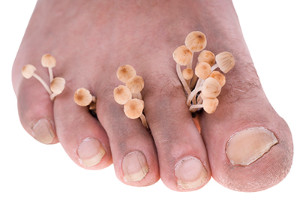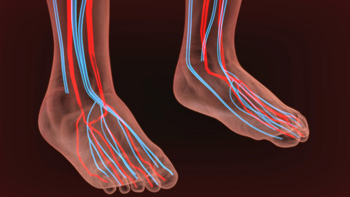 A fungal infection that is referred to as athlete’s foot can be uncomfortable and painful. The most common place for this condition to develop is between the toes, which may cause severe itching. The skin may become dry and flaky, and many patients notice a burning or stinging sensation. This ailment is known to be contagious, and lives in warm and moist environments. These areas many include swimming pools, shower room floors, or locker rooms. Additionally, athlete’s foot may develop as a result of wearing shoes and socks that are too tight. This can contribute to sweaty feet, which may create an environment for the fungus to thrive. There are measures that can be implemented, which may help to prevent athlete’s foot. These may include wearing appropriate shoes in public areas and washing the feet and completely drying between the toes. If you are afflicted with this condition, it is suggested to consult with a podiatrist who can guide you toward proper treatment.
A fungal infection that is referred to as athlete’s foot can be uncomfortable and painful. The most common place for this condition to develop is between the toes, which may cause severe itching. The skin may become dry and flaky, and many patients notice a burning or stinging sensation. This ailment is known to be contagious, and lives in warm and moist environments. These areas many include swimming pools, shower room floors, or locker rooms. Additionally, athlete’s foot may develop as a result of wearing shoes and socks that are too tight. This can contribute to sweaty feet, which may create an environment for the fungus to thrive. There are measures that can be implemented, which may help to prevent athlete’s foot. These may include wearing appropriate shoes in public areas and washing the feet and completely drying between the toes. If you are afflicted with this condition, it is suggested to consult with a podiatrist who can guide you toward proper treatment.
Athlete’s foot is an inconvenient condition that can be easily reduced with the proper treatment. If you have any concerns about your feet and ankles, contact Dr. Morris Stribling from Foot Care of Central San Antonio. Our doctor will treat your foot and ankle needs.
Athlete’s Foot: The Sole Story
Athlete's foot, also known as tinea pedis, can be an extremely contagious foot infection. It is commonly contracted in public changing areas and bathrooms, dormitory style living quarters, around locker rooms and public swimming pools, or anywhere your feet often come into contact with other people.
Solutions to Combat Athlete’s Foot
Athlete’s foot can cause many irritating symptoms such as dry and flaking skin, itching, and redness. Some more severe symptoms can include bleeding and cracked skin, intense itching and burning, and even pain when walking. In the worst cases, Athlete’s foot can cause blistering as well. Speak to your podiatrist for a better understanding of the different causes of Athlete’s foot, as well as help in determining which treatment options are best for you.
If you have any questions please feel free to contact our office located in Central San Antonio, TX. We offer the newest diagnostic and treatment technologies for all your foot and ankle needs.
Read more about Athlete's Foot 101 There is a band of tissue that is located on the bottom of the foot. This band, known as the plantar fascia, connects the toes to the heel bone. If the plantar fascia should become inflamed and irritated, a condition that is referred to plantar fasciitis may develop. Symptoms that are characteristic of this condition may include pain and discomfort, in addition to the heel appearing stiff and swollen. Typical reasons for plantar fasciitis to develop may include standing for extended periods of time or wearing shoes that do not fit properly. Additionally, this ailment may develop in patients who participate in long distance running. Certain medical conditions, such as flat feet or high arches, may be contributing factors for the onset of plantar fasciitis. Mild relief may be found while resting the affected foot, and it may be helpful to abstain from engaging in the activities that may have caused the condition. If you have heel pain, consult with a podiatrist who can offer proper treatment options.
There is a band of tissue that is located on the bottom of the foot. This band, known as the plantar fascia, connects the toes to the heel bone. If the plantar fascia should become inflamed and irritated, a condition that is referred to plantar fasciitis may develop. Symptoms that are characteristic of this condition may include pain and discomfort, in addition to the heel appearing stiff and swollen. Typical reasons for plantar fasciitis to develop may include standing for extended periods of time or wearing shoes that do not fit properly. Additionally, this ailment may develop in patients who participate in long distance running. Certain medical conditions, such as flat feet or high arches, may be contributing factors for the onset of plantar fasciitis. Mild relief may be found while resting the affected foot, and it may be helpful to abstain from engaging in the activities that may have caused the condition. If you have heel pain, consult with a podiatrist who can offer proper treatment options.
Plantar fasciitis is a common foot condition that is often caused by a strain injury. If you are experiencing heel pain or symptoms of plantar fasciitis, contact Dr. Morris Stribling from Foot Care of Central San Antonio. Our doctor can provide the care you need to keep you pain-free and on your feet.
What is Plantar Fasciitis?
Plantar fasciitis is one of the most common causes of heel pain. The plantar fascia is a ligament that connects your heel to the front of your foot. When this ligament becomes inflamed, plantar fasciitis is the result. If you have plantar fasciitis you will have a stabbing pain that usually occurs with your first steps in the morning. As the day progresses and you walk around more, this pain will start to disappear, but it will return after long periods of standing or sitting.
What Causes Plantar Fasciitis?
There are some risk factors that may make you more likely to develop plantar fasciitis compared to others. The condition most commonly affects adults between the ages of 40 and 60. It also tends to affects people who are obese because the extra pounds result in extra stress being placed on the plantar fascia.
Prevention
There are a variety of treatment options available for plantar fasciitis along with the pain that accompanies it. Additionally, physical therapy is a very important component in the treatment process. It is important that you meet with your podiatrist to determine which treatment option is best for you.
If you have any questions, please feel free to contact our office located in Central San Antonio, TX. We offer the newest diagnostic and treatment technologies for all your foot care needs.
Read more about Plantar Fasciitis
 If you experience a tingling or numbing sensation in the nerves of the feet, you may have a condition that is referred to as peripheral neuropathy. This may occur as a result of genetic traits or medical conditions that may include thyroid disorders or diabetes. Additionally, the aging process or taking certain medications may add to the risk of developing neuropathy. Some of the symptoms that may be noticed can include weakness, clumsiness, or a loss of balance. Patients may feel cramping in the hands and feet or may feel dizzy while standing up from a chair. There may be medications that may be effective in treating neuropathy. If this condition occurs as a result of radiation or chemotherapy, successful recovery may take eighteen months or longer. If you are experiencing any symptoms of this condition, it is suggested to consult with a podiatrist who can properly guide you toward the correct treatment techniques.
If you experience a tingling or numbing sensation in the nerves of the feet, you may have a condition that is referred to as peripheral neuropathy. This may occur as a result of genetic traits or medical conditions that may include thyroid disorders or diabetes. Additionally, the aging process or taking certain medications may add to the risk of developing neuropathy. Some of the symptoms that may be noticed can include weakness, clumsiness, or a loss of balance. Patients may feel cramping in the hands and feet or may feel dizzy while standing up from a chair. There may be medications that may be effective in treating neuropathy. If this condition occurs as a result of radiation or chemotherapy, successful recovery may take eighteen months or longer. If you are experiencing any symptoms of this condition, it is suggested to consult with a podiatrist who can properly guide you toward the correct treatment techniques.
Neuropathy
Neuropathy can be a potentially serious condition, especially if it is left undiagnosed. If you have any concerns that you may be experiencing nerve loss in your feet, consult with Dr. Morris Stribling from Foot Care of Central San Antonio. Our doctor will assess your condition and provide you with quality foot and ankle treatment for neuropathy.
What is Neuropathy?
Neuropathy is a condition that leads to damage to the nerves in the body. Peripheral neuropathy, or neuropathy that affects your peripheral nervous system, usually occurs in the feet. Neuropathy can be trigged by a number of different causes. Such causes include diabetes, infections, cancers, disorders, and toxic substances.
Symptoms of Neuropathy Include:
Those with diabetes are at serious risk due to being unable to feel an ulcer on their feet. Diabetics usually also suffer from poor blood circulation. This can lead to the wound not healing, infections occurring, and the limb may have to be amputated.
Treatment
To treat neuropathy in the foot, podiatrists will first diagnose the cause of the neuropathy. Figuring out the underlying cause of the neuropathy, whether it be diabetes, toxic substance exposure, infection, or others, will allow the podiatrist to prescribe the best treatment. If the nerve has not died, then it’s possible that sensation may be able to return to the foot.
Pain medication may be issued for pain. Electrical nerve stimulation can be used to stimulate nerves. If the neuropathy is caused from pressure on the nerves, then surgery may be necessary.
If you have any questions, please feel free to contact our office located in Central San Antonio, TX. We offer the newest diagnostic and treatment technologies for all your foot care needs.
Read more about Neuropathy